Stock assessments
Marine Scotland scientists look at four main characteristics of an exploited fish population to determine its ‘health’:
- Fishing Mortality (F) — A measure of the proportion of a fish stock taken each year by fishing;
- Spawning Stock Biomass (SSB) — The total weight of mature fish (capable of spawning) in the population;
- Recruitment — The number of young fish produced each year which survive from spawning to enter the adult stock and the fishery;
- Landings — The total annual tonnage of fish taken from the stock and landed by the fishing fleet.
Every year, scientists at MSS, as well as other members of the International Council for the exploration of the Sea (ICES), look at the changes in these characteristics and forecast what is likely to happen in the future. In general the predictions are based on a pool of information provided by several european fishing nations. The process of estimating the past and current state of the stock is known as stock assessment.
Information Required for Stock Assessment
To carry out a stock assessment it is necessary to build up a picture of how the fish populations change over time, and examine the historical trends. The information required comes from market sampling, discard sampling and research vessel surveys.
Market Sampling
Throughout the year, landings at Scottish fish markets are sampled regularly by staff from MSS. Information on length and age are collected along with details of the catches of the fishing fleets. The most common method used to age fish is to examine the ear stone or otolith which is found in the head of the fish. These bony structures give an accurate picture of the life history of the individual fish. They consist of layers that are built up like the rings on a tree. each year can be identified by a dark and light band corresponding to winter and summer growth. The age of the fish can be determined by counting the number of bands on the otolith. By counting the ages of a large number of fish the age structure of the whole population can be estimated. This gives a good indication of how the stock is standing up to the effects of fishing. If there are not many young fish, then recruitment has been poor and this could mean problems for the future. If there are no old fish present in the stock, this could be an indicator of over-fishing. If the stock is in a healthy state, fish of a wide range of ages are present. each year MSS staff sample around 1,000 catches from the landings of 18 different species. Approximately 800,000 fish are measured and around 90,000 are aged.
Observer Sampling
Sampling the landings is very important but it gives no information about those fish which are caught that never reach the market. Many of the fish caught at sea are thrown away, either to comply with the quota limits or because they have no commercial value, or because they are below the legal minimum landing size. with the cooperation of the fishing industry, MSS staff carry out around 80 voyages a year to collect information on the amount of fish discarded, as well as details of their length and age composition. each year around 280,000 discarded fish are measured and 14,000 are aged. This information is then combined with the landings’ data to give a complete picture of the effects of fishing on the stocks.
Research Vessel Surveys
research vessel surveys give information on the numbers of young fish ‘recruits’ which are too small to be caught and landed by commercial vessels. They also provide information on changes in the distribution and abundance of the adult stock. Bottom trawling surveys are used for cod, haddock and whiting, whereas acoustic surveys are used for herring. Shoals of herring show up on echo-sounders as ‘marks’. Analysis of the strength of the echo-soundings gives an estimate of the total biomass. for mackerel, surveys are carried out to estimate the total number of eggs produced during the spawning season. This is used in combination with information on the numbers of eggs produced by female mackerel of different lengths to estimate the size of the population.
Agreeing fish stocks
Introduction
Most stocks exploited by Scottish fishermen are managed under the Common fisheries Policy (CFP) by the european Commission. An important part of the management procedure is the use of Total Allowable Catches (TACs). These are intended to allocate fish resources to different member states and to control the amount of fish removed each year.
Most TACs are set on an annual basis and are the result of a cycle of events ending in the december Council of fisheries Ministers, which decides on the final TACs for the following year. fixing the level of fish quotas that can be caught by EU member states is a complex process and EU fisheries ministers have the final say on the quotas to be allocated for the next twelve month period. Sometimes scientific advice on how much of a certain species should be caught is followed to the letter, but it is not unusual for ministers to agree on levels which are very different from the European Commission’s initial proposals.
Different quotas are applied to different areas for different species, the so-called TAC areas, for example, the TAC area for North Sea whiting comprises International Council for the exploration of the Sea (ICES) divisions Iva,b,c and vIId.
It is also important to remember that before the december Council of fisheries Ministers meeting takes place, an agreement must be reached with Norway — not an EU member — on quota shares. This is because the main North Sea demersal and pelagic stocks are shared by Norway and the EU. While TACs are strongly influenced by politics and have generally not been recommended by scientists as the appropriate management measure for demersal stocks, they are based on the work of national research institutes. each country collects basic biological data from fish landings, observer and research vessel surveys.
This information is then used by ICES working groups, to assess the state of the stocks. These assessments usually consist of:
- An estimate of the historical trends in landings, spawning stock biomass, recruitment and fishing mortality rate;
- A description of the ‘state of the stock’ in relation to historical levels;
- The likely medium term development of the stock using different rates of fishing mortality;
- A short term forecast of spawning stock biomass and catch.
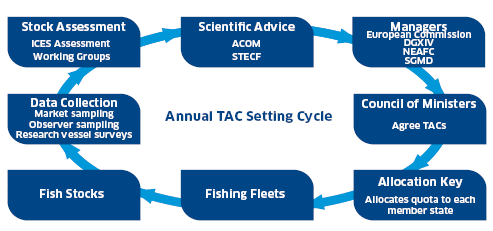
Assessments performed by the working groups are considered by the Advisory Committee (ACOM), an ICES committee with representatives from each country. ACOM decides what the official ICeS advice on the management of the stocks will be.
For the purposes of TACs, ACOM provides a catch option table for managers consisting of expected catches under different fishing rates, and usually indicates which of the options corresponds most closely to its advice. The advice given is based upon what is likely to happen in the medium term, if the stock is fished at a particular level. Generally the advice is to fish at a level that gives good odds of avoiding a dangerously low spawning size.
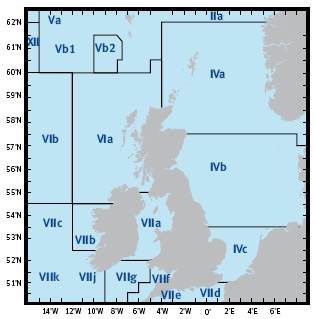
The Commission drafts its proposals for TACs in the next year using the ICES advice and any other factors that it considers appropriate. for example, the Commission may ask its own advisory body, the Scientific, Technical and economic Committee on fisheries (STECF), for guidance on the economic effects of the scientific advice. Between the time the ICES advice becomes available and the time of the december Council of fisheries Ministers, the Commission consults with member states about the measures for managing fisheries in the coming year. At this time, member states have the opportunity to influence the Commission in the drafting of the TAC regulation. It is also at this time that the Commission negotiates TACs for jointly managed stocks with Norway. The joint stocks affecting Scotland in the North Sea, are cod, haddock, whiting, saithe, herring and mackerel.
The Commission has the unique responsibility to make a formal proposal about the forthcoming TACS. No other body within the eu may do this, not even the Council or the Presidency. The power to make policy proposals lies with the Commission. however, it is the Council of Ministers which makes the final decision. The Council can reject the Commission’s proposals and then ask for alternatives from them. Generally the Commission tries to draft a proposal which will be acceptable to all member states. There is a lengthy process of consultation up to and including the Council meeting to find a compromise.
Once a compromise has been agreed by the Council of Ministers, there is an almost automatic process of allocating shares of the total TACs to member states. This is done on the basis of an allocation key which was established early in the history of the CFP. The key reflects fishing patterns in the early 1980s which raises problems for certain stocks, notably saithe. Historically, the UK had little interest in landing saithe and consequently it has only a small proportion of the TAC. This means in the present day that it is unable to land the quantity of saithe that it is likely to catch.
Following the allocation of the TACs to member states, the principle of subsidiarity operates. Each member state can administer its quota according to its own preferences provided the catch limits are adhered to and that all member state fishermen are treated equally. In the UK, the trend has been for Government to hand the management of quotas to the producer organisations (POs). These organisations, run by fishermen, decide how to manage the quotas during the course of the year and usually try to ensure that the fishery remains open for the whole year.
ICES advice
Introduction
The International Council for the exploration of the Sea (ICES) has adopted the Precautionary Approach to fishery management in preparing its advice.
Given the uncertainty of stock estimates, there is a need to define levels of biomass and fishing mortality rate which trigger management action before stocks reach dangerously low levels. for the stocks to be within safe biological limits, there should be a high probability that the spawning stock biomass (SSB) remains above a minimum level. In addition, the fishing mortality rate (F) should be below a rate likely to drive the SSB below acceptable levels.
ICES has defined a quantity, Bpa, as its precautionary biomass reference point. If SSB falls below Bpa, then management action should be taken to increase it. Similarly, it has defined a precautionary reference point for the fishing mortality rate, Fpa. If F exceeds Fpa, then management action should be taken to reduce it. In addition to these so-called ‘precautionary’ reference points, ICES has also defined what can be termed ‘limit’ reference points relating to both SSB (Blim) and fishing mortality (Flim). Blim is set at a value below Bpa, at a point where there is a serious risk that the reproductive capacity of the stock may be critically impaired. Flim is set at a value above Fpa, and is the level of fishing mortality that is likely to drive SSB to or below Blim.
ICES also adopted some specific phrases that it used to describe the condition of a stock relative to its precautionary reference points. however, experience has shown that some of the terms used are prone to being misunderstood and, in response, ICES introduced a new set of terms in 2004 to describe the state of a stock. In addition, as part of recent developments in fisheries management, ICES has moved from giving advice on individual fish stocks (stock-based advice) to the provision of advice on the basis of mixed fisheries (fisheries-based advice). This, in turn, can be considered a step on the path towards developing a more integrated ecosystem approach to fisheries management.
All of these developments are reflected in the terms and phrases that ICES uses in its advisory role and in the information it produces. This section describes the language used by ICES and outlines the changes that have been made and the reasons behind the changes.
Terminology used prior to 2004
ICES has always updated its form of advice in line with developments in fisheries management and a section on the form of advice has generally accompanied the publication of its annual scientific advice.
In the years immediately prior to 2004, ICES used some very specific phrases to describe the state of a stock. If an assessment indicated that the spawning biomass was below Bpa the stock was classified as being ‘outside safe biological limits’, regardless of the fishing mortality rate. In such a case ICES provided advice to increase spawning biomass above Bpa, which may also have involved reducing fishing mortality. If Bpa could not easily be reached in the short term, ICES then recommended the development of a recovery plan, specifying measures to increase SSB above Bpa in an appropriate time scale.
When an assessment indicated that the stock was above Bpa but that the fishing mortality was above Fpa, it was classified as ‘harvested outside safe biological limits’. ICES would then recommend that the fishing mortality be reduced below Fpa in the short term. This scheme is illustrated in figure 1 below.
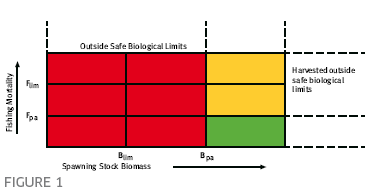
Being outside safe biological limits meant that the ability of a stock to replace itself was reduced. It did not indicate an imminent risk of biological extinction. Despite a clear explanation of this, and usage of the same phrase in international agreements, some recipients of the ICES advice misunderstood its meaning and it was sometimes mistakenly equated with a risk of biological extinction.
The current form of words
The earlier form of advice was based on individual fish stocks and, because of this, the interactions between species in mixed fisheries were sometimes interpreted to be of secondary importance. To emphasise the need to consider interactions between fisheries and stocks, rather than relying solely on single species advice, ICES no longer gives single species advice. It continues to comment on the state of individual fish stocks, and illustrate the limits of exploitation that could be appropriate if a stock was considered in isolation. It refers to these limits as the single stock exploitation boundaries. These only comprise the ICES advice in cases where there are no mixed fisheries concerns or ecosystem concerns beyond the impact of exploiting that stock. In all other cases the advice is now presented in a mixed-fishery context in which the advice for one species is conditioned on the advice for the others. If there is a need to reduce the rate of exploitation for one species, then the advice will require a coherent reduction in the rate of exploitation for the other species too.
In its current advisory report format, ICES seeks to:
- Distinguish between fisheries advice and advice on other marine uses, but with both in an ecosystem context;
- Recognise the interactions within and between fisheries, and to advise appropriately;
- Incorporate targets for exploitation rates rather than relying solely on limits and boundaries, i.e., to define an objective to move towards rather than defining boundaries to be avoided.
To work towards these aims, and to address some of the concerns over misinterpretations of the words that used, in 2004, ICES adopted a new set of descriptions for indicating the state of a stock to be used along with the single-species exploitation boundaries.
If SSB is above Bpa, the stock is considered to have ‘full reproductive capacity’. If it is between Bpa and Blim then it is considered to be ‘at risk of reduced reproductive capacity’, and below Blim it is either ‘suffering reduced reproductive capacity’ or it is at a level where the ‘stock dynamics are unknown’. Either of the cases where SSB is below Bpa correspond to the previous definition of a stock as outside safe biological limits.
For fishing mortality, where it is less than Fpa the stock is considered to be ‘harvested sustainably’. If it is between Fpa and Flim then it is ‘at risk of being harvested unsustainably’, and above Flim it is ‘harvested unsustainably’. The latter two cases correspond to the previous definition of a stock harvested outside safe biological limits.
This new scheme is illustrated in figure 2 below.

ICES has emphasised that it considers the expressions ‘outside safe biological limits’ and ‘being at risk of reduced reproductive capacity’ or ‘suffering reduced reproductive capacity’ to be entirely equivalent and that the change in language does not imply any change in judgement regarding the seriousness of the situation when a stock is outside precautionary limits.
This can be illustrated by an examination of the old and new schemes presented in this section. In terms of the Precautionary Approach to fisheries management, the best place to be in either figure 1 or 2 is in the bottom right-hand corner, where SSB is above its precautionary threshold and fishing mortality is less than its precautionary value. The worst place to be is in the top left-hand corner, where SSB is below its limit threshold, and fishing mortality is above its limit value. In the old scheme, a stock whose status put it at the top left would be described as ‘outside safe biological limits’. Now it is defined as ‘suffering reduced reproductive capacity’ and ‘harvested unsustainably’.
Mixed species advise
Introduction
The International Council for the exploration of the Sea (ICES) has traditionally given fishery management advice on an individual stock basis. for each assessed stock, catch options corresponding to the formal ICES advice are provided for the following year and form the basis of the Total Allowable Catch (TAC) for that stock. The TAC is the total landing allowed to be taken from that stock by all fleets. for demersal fisheries in particular this approach is deficient since it disregards the fact that mixtures of roundfish, flatfish and shellfish are often caught simultaneously within a single fishery. Moreover, fish stocks are targeted by different fleets, each catching different mixes of species.
Ignoring the mixed-species aspect of fisheries can mean, for example, that the quota for one species may become exhausted, but due to the continued quota availability for other species, vessels continue to fish and inevitably catch the species whose quota is exhausted. The required constraints on fishing mortality for vulnerable species are not always therefore operative. Alternatively, early closure of a fishery because one species needs protection could result in the loss of fishing opportunities on other stocks.
Approaches investigated
Both ICES and the european Commission are investigating a number of ways to advise on and manage mixed-species fisheries.
One option is that advice is provided on a fleet or fishery basis. This requires evaluation of fisheries in a multi- fleet framework. Management under such a framework requires judgements from fishery managers on the relative species importance, since broadly equivalent outcomes for one species may be reached in a number of ways with very different restrictions on other species.
A simple example of management options for three fleets catching three species (cod, haddock and Nephrops) is illustrated overleaf. Panel ‘a’ shows the historic catch composition. Fleet one catches a mixture of all three species, fleet two catches cod and haddock, and fleet three cod and Nephrops.
Now imagine that catches of haddock and Nephrops can be maintained but there is a need to protect cod and reduce catches of it by 50 per cent. Panel ‘b’ shows the effect on the catches of all three species of reducing cod catches evenly across all fleets. Panel ‘c’ shows the option where priority is also given to maintaining haddock catches, and results in closing down fleets one and three. Panel ‘d’ shows the outcome of prioritising cod, then Nephrops and finally haddock.
This distributes the permissible cod catches firstly to the catch associated with Nephrops in fleet three and then to a significant but lesser extent to the catch associated with haddock in fleet two. Thus managers have complex decisions to take, but the mixed fisheries approach can help to maximise fishing opportunities.
Simpler approaches for two or three species have used landings data at the statistical rectangle level (and sometimes from different fleets) to identify areas where fisheries for certain species can be conducted with minimal impact on the species requiring greater protection.
Some approaches based on historical data assume constant species compositions over time and effectively discourage adaptive fishing
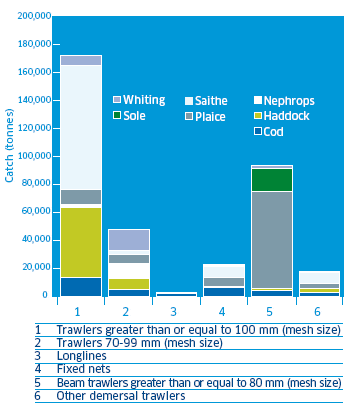
behaviour. fishermen have demonstrated the ability to reduce by-catch through season, area or gear modifications, or changes in their shortterm fishing patterns. There is a danger that the allocation of fishing opportunities based on past catch compositions will lock fisheries into their historical pattern, providing no incentive to reduce by-catch. Such adaptive changes in fishing behaviour are difficult to predict but to the extent that they occur, they will affect the realism of mixed fishery forecasts.
Future possibilities
The framework for mixed fishery evaluation has progressed greatly in the last few years and experience of fisheries-based management in other parts of the world indicates that provision of this type of advice is possible.
If fisheries-based advice is to be useful for managing mixed-species fisheries there are major challenges implied by likely changes in the share of each species’ TAC allocated to each fleet or country. Indeed, fisheries-based advice may be more appropriately directed to effort-based fisheries management, rather than to catch controls (TACs).
Such an approach is also seen as a means to bridge the gap between ‘traditional’ fisheries management and the development of an ecosystem approach to marine management.
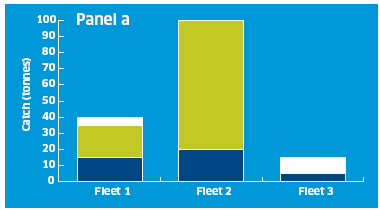



April 2010


